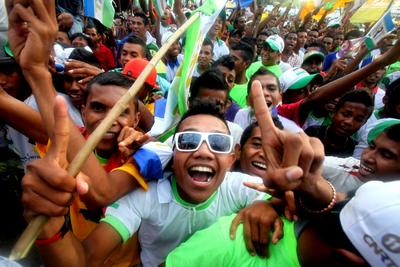Eighteen parties and three coalitions will hit the hustings, competing for seats in the 65-seat national parliament. Barring a sensational performance from one of the major parties, Timor-Leste’s proportional electoral system makes a post-electoral coalition the likely outcome.
Much is riding on a peaceful election. If all goes well, both the UN police and the Australian-led International Stabilisation Force will withdraw from the country late in 2012. A successful and widely accepted result in the parliamentary elections will be the key to democratic consolidation. The successful conduct of the two-round presidential elections in March and April, which saw the former military-resistance commander and retired defence chief Taur Matan Ruak become the new president, was a significant and positive outcome.
Since 2007 Timor-Leste has been governed by the Parliamentary Majority Alliance (AMP), a coalition of parties headed by the current prime minister, Xanana Gusmão. The Revolutionary Front for an Independent East Timor (Fretilin), which formed the first post-independence government in 2002, currently serves as the opposition. Though there is little in the way of polling, the major election issues are clear: management of the country’s US$10 billion petroleum fund, development policies, and preserving peace and stability.
Though it finished second in the 2007 elections, Xanana Gusmão’s National Congress for Timorese Reconstruction (CNRT) has been the lead party in the governing coalition — alongside a smaller coalition of the Timorese Social Democratic Association and the Social Democratic Party (the ASDT-PSD) and the Democratic Party (PD). The CNRTs electoral strengths include its high profile leader, the relative peace and stability the country has enjoyed since 2008, and the active support it gave the popular new president during his own campaign.
Fretilin — still the largest single party — has a lot at stake in this election, but is not without some advantages, including a well-organised district structure and a committed membership base. A level of popular disaffection with limited development progress in the rural areas and clear tensions within the AMP coalition could also work in Fretilin’s favour.
The wild card in the election is the former president and leader of the diplomatic front, José Ramos-Horta. Capitalising on his reputation as a bridge builder, Ramos-Horta expressed his support for PD, led by the president of the parliament and former clandestine resistance leader Fernando ‘Lasama’ de Araujo. The PD’s support base includes a younger generation of independence supporters educated in the Indonesian era. Yet the party underperformed in 2007, receiving 11 per cent of the vote, and is hampered by divisions between key leaders from the east and west of the country.
Although Ramos-Horta’s support has boosted the PD, he has not joined their list of candidates — nor has he joined the party. In fact, Ramos-Horta has also lent active campaign support to ASDT, and has publicly signalled his desire to have Fretilin included in the next government as a means of unifying the east and west of the country. It seems reasonably clear that Ramos-Horta’s strategy is to help build up both PD and Fretilin — along with ASDT — to increase the chances of forging a coalition against CNRT. Either way, given Ramos-Horta’s personal following, if PD can reconcile their internal differences then they could perform well in this election, emerge as the new ‘third party’, and potentially become the kingmakers in July.
Given Timor-Leste’s proportional system, it is most unlikely that any party will secure a majority of 33 seats, and this raises the issue of coalition building. With party dispositions far less certain than in 2007, there are three possibilities.
The first is a new rendition of an AMP coalition based around CNRT and smaller parties. The second is a coalition based on Fretilin, which could involve the ASDT and others. Lastly, there is the outlier possibility of a grand coalition between Fretilin and CNRT. All the talk about brokering elite post-electoral deals should not be a source of concern; rather, the fact that a range of coalition options are being actively discussed is a good sign of mature political negotiations in a critical election for the East Timorese state.
In the wake of this election Timor-Leste’s often-fractious political elites will have to play the long game because once the UN departs for the second time, another crisis cannot be contemplated. Some parties are asking for votes on the basis of their ability to guarantee peace and stability, but stability should be guaranteed regardless of whether they are voted into office. For at least one of the main parties, 2012 will bring defeat. It will fall upon whoever ends up in opposition to assist in setting the tone for democratic consolidation after the UN era. And there is little doubt that the new president will play a key role in emphasising these points after 7 July.
Michael Leach is Associate Professor in Politics at Swinburne University of Technology.
A version of this article was first published hereon Inside Story.

